#Devi Maa Skandamata
Explore tagged Tumblr posts
Text
Happy Sharada Navaratri
Are you celebrating this Sharada Navaratri? This year the festival is held from Sunday, October 15th to Tuesday, October 24th, for the usual nine nights and ten days. The festival is celebrated in the Hindu month of Ashvin – the seventh month of the lunisolar Hindu calendar – and is considered as being an auspicious time of the year. On Navaratri, Hindus celebrate the goddess Durga‘s battles…

View On WordPress
#avatar#Brahmacharini#Chandraghanta#classical dance#Devi Maa Brahmacharini#Devi Maa Chandraghanta#Devi Maa Kalratri#Devi Maa Katyayani#Devi Maa Kushmanda#Devi Maa MahaGauri#Devi Maa ShailPutri#Devi Maa Siddhidatri#Devi Maa Skandamata#Durga#folk dance#Goddess Durga#Hindu#India#Indian Culture#Indian Tradition#Kalratri#Katyayani#Kushmanda#Mahagauri#Navaratri#Navdurga#pandal#Raffaello Palandri#Shailputri#Siddhidatri
35 notes
·
View notes
Text
Skandamata is the fifth of the nine forms of Goddess Durga who is worshipped on the fifth day of Navratri. She is shown as a four-armed goddess, with two of them holding a lotus bloom each. She also rides a lion while carrying her son Lord Kartikey (in his toddler form) on her lap.
In Hindu mythology, Skandamata is regarded as the mother of Lord Murugan, also known as Kartikeya or Skanda. She is seen as a representation of maternal care and defence. “Mother of Skanda” is the meaning of her name, Skandamata. Worshipping Goddess Skandamata leads to the worship of Lord Kartikey and results in the fulfilment of sincere wishes and desires.
D'Vine Yoga is starting a new batch from 1st November 2024 with 5% off in the green valley of Uttarakhand 'Rishikesh' Only a few seats left for November YTTC.
Hurry up! Grab the opportunity and book your slots now.
Contact Details ☎ Whatsapp: +919997224320 📞 Website: www.artdivine.org 🌐 Email: [email protected] 📩
#navratri#navratrispecial#garba#india#durgapuja#Rishikesh#jaimatadi#durga#festival#love#instagram#devi#maa#navratricollection#garbanight#durgamaa#hinduism#indianfestival#instagood#indian#dvineyoga#5%off#november#Skandamata#offermonth#fireceremony
0 notes
Text
Day five of Navratri
9 days , 9 Godesses
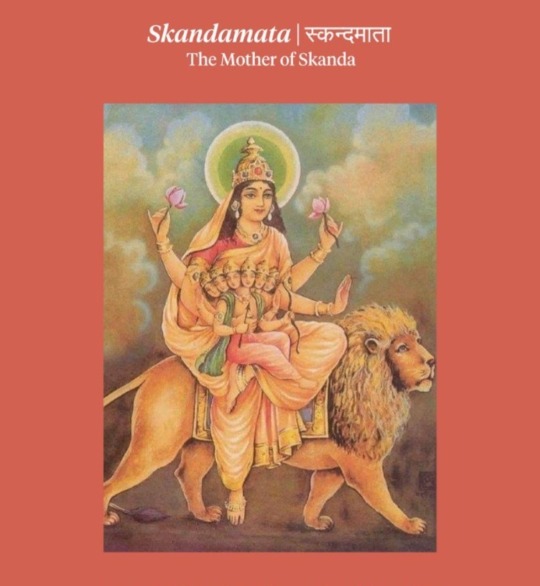
Day 5 : Skandamata | स्कन्दमाता
Parvati, in her role as the mother of Skanda or Shanmukha, came to be known as Skandamata. She gives her devotees salvation, power and prosperity. She can grant wisdom even to the most illiterate person if he worships her with complete devotion. He who is selflessly devoted to her attains all the achievements and treasures of life.
While worshiping her, we should have absolute control over our senses and mind. We should worship her with a single-pointed devotion. Her worship is twice blessed.
Mantra of the day :
ॐ देवी स्कन्दमातायै नमः॥
Aum Devi Skandamatayai Namaha!
Jai Maa Durga 🔱
16 notes
·
View notes
Text

Grace of Maa Skandamata :: Day 5 of Navratri Celebrations at Mewar University
On this auspicious day of Navratri, we invoke the blessings of Maa Skandamata, the fifth form of Devi Durga. Join us in our vibrant celebrations at Mewar University as we pay homage to the divine mother and seek her guidance and protection. 🙏
#Navratri2023 #MaaSkandamata #Navratri #NavratriWishes #DurgaPuja #NavratriBlessings #FestiveSeason #GoddessDurga #DivineFestival #MaaDurga #FestivalVibes #SpiritualVibes #BlessingsOfMaa #TopUniversityInRajasthan #MewarUniversity #BestUniversityInRajasthan #Cuet #KnowledgeToWisdom #ApplyNow #FestivalOfJoy #IndianFestivals
2 notes
·
View notes
Text
Difference between Chaitra Navratri and Sharad Navratri
Reading time- 5 mins
India, a land of diverse cultures and traditions, celebrates Navratri not once, but twice a year with great enthusiasm and devotion. Navratri, meaning 'nine nights,' is a Hindu festival dedicated to Goddess Durga and her various forms. These two celebrations, Chaitra Navratri and Sharad Navratri, hold unique significance and are observed at different times of the year. In this blog, we'll explore why Navratri is celebrated twice in India and delve into the captivating mythological stories behind the divine forms of Maa Durga.
Chaitra Navratri: Welcoming Spring
Chaitra Navratri falls in the Chaitra month of the Hindu calendar, typically in March or April. This festival marks the beginning of spring when nature awakens, and new life blossoms. During these nine days, devotees pay homage to Goddess Durga and seek her blessings for prosperity and good fortune.
Chaitra Navratri is believed to commemorate the day when Lord Rama, accompanied by his brother Lakshmana and devotee Hanuman, worshiped Goddess Durga to seek her blessings before embarking on his epic journey to rescue his wife, Sita, from the demon king Ravana. It symbolizes the victory of good over evil and the triumph of righteousness. The culmination of Chaitra Navratri is celebrated as Ram Navami.
Sharad Navratri: Celebration of the Harvest
Sharad Navratri, also known as Maha Navratri, is the more widely celebrated of the two. It falls in the lunar month of Ashwin, usually in September or October when the monsoon season ends and the country gears up for the harvest season. This grand festival celebrates the divine feminine and the goddess's prowess in defeating the buffalo demon, Mahishasura.
According to Hindu mythology, Mahishasura was a formidable demon who terrorized the gods. He received a boon from Lord Agni, according to which a woman would only kill him. Unable to defeat him, the gods created Goddess Durga, a symbol of ultimate feminine power. Durga fought Mahishasura for nine days and nights, ultimately slaying him on the tenth day, known as Vijayadashami or Dussehra. Sharad Navratri symbolizes the victory of good over evil, knowledge over ignorance, and light over darkness. It is the ultimate celebration of divine female energies.
Young girls all over India are worshipped as devotees who believe that the Devi resides in little girls.
Maa Durga is depicted in 9 various forms, each with its own significance and attributes, to defeat the shape-shifting demon: Mahishasura. During Navratri, these forms are celebrated on specific days, known as 'Navadurga.' Let's explore some of the most renowned forms:
Shailaputri: The first form of Durga, she is the daughter of the Himalayas and represents the purity and innocence of nature.
Brahmacharini: She symbolizes the pursuit of knowledge and is often depicted holding a rosary and a water pot.
Chandraghanta: This form represents bravery and courage, as she adorns a crescent moon-shaped ornament on her forehead.
Kushmanda: The creator of the universe, Kushmanda signifies the source of all energy and vitality.
Skandamata: As the mother of Lord Kartikeya, she stands for the power of a mother's love and protection.
Katyayani: This fierce form of Durga is worshiped for her ability to destroy evil forces and protect her devotees.
Kalratri: Depicting the dark side of life, she is a symbol of destruction and liberation from ignorance.
Mahagauri: This form represents purity and is often depicted in white attire, symbolizing peace and serenity.
Siddhidatri: The final form of Durga, Siddhidatri is believed to grant devotees spiritual powers and enlightenment.
Navratri is a spiritually enriching festival that honors the divine feminine. Whether it's the arrival of spring during Chaitra Navratri or the harvest season of Sharad Navratri, both celebrations remind us of the importance of faith, perseverance, and the victory of good over evil. The diverse forms of Maa Durga teach us valuable life lessons and inspire us to live virtuously.
Gujratis celebrate Navratri through vibrant Garba and Dandiya Raas dances, while in Bengal, this festival is celebrated as Durga Puja, which involves worshiping the goddess Durga with grand processions and cultural events. So, they celebrate Navratri, but how it's celebrated varies.
This Navaratri, bring home the divine presence of Goddess Durga with the Navaratri-Durga Puja Kit from Prabhu Shriram- Incense with a Story.
This pack contains-
Mata Vaishno Devi Agarbatti
Upasana Dhoop
Sambrani Cups
Havan Samagri
Divya Jyot
Mauli Dhaga
Guggal Loban
Jau
Pavitra Ganga Sand Soil
Red Cloth
Mata Chunri
Laung
Supari
Sindoor/Roli
Haldi
Akshat
Mishri/Kaju/Kishmish/Elaichi
Camphor
2 notes
·
View notes
Text
Chaitra Navratri 2023: Rituals,Yoga, Days And Pujas To Perform
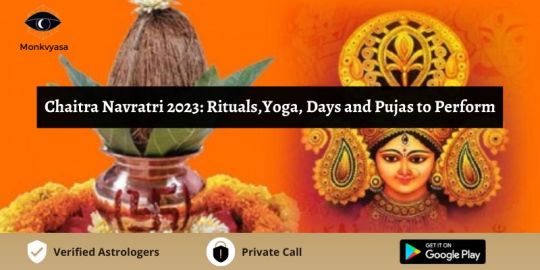
Navratri is a significant Hindu festival that is celebrated for nine nights on the Indian subcontinent during autumn. Traditionally, there are four seasonal Navratris, and the Sharada or Shardiya Navratri is celebrated after the monsoon season in remembrance of the Divine Feminine Devi. During this time, Hindus perform the customs and rites of Ghatasthapana and Sandhi Puja, which are considered to be the two most frequently observed muhurtas. Chaitra Navratri 2023 is particularly significant as it falls during the Shardiya Navratri, and Hindus observe the customs and rituals of Ghatasthapana and Sandhi Puja during this time.
The Navratri puja, also known as Vasanta Navratri, is a celebration that honors the sacred feminine Devi or Durga. Devotees worship and honor Divine Durga in her nine forms during this festival. The word "Vasanta" is derived from the Sanskrit language and signifies spring, which is when this Navratri occurs. It takes place during the Chaitra lunar month, which typically falls between March and April after the winter season. In some regions, this festival is celebrated after the spring season, while in others, it is observed after the harvest season. It is also significant as it marks the first day of the Hindu calendar, making it the Hindu New Year according to the Vikram Samvat calendar.
Chaitra Navratri 2023: Navratri days & pujas to perform
Here are the dates and details for Chaitra Navratri 2023:
Wednesday, 22 March 2023 (Pratipada): Maa Shailputri Puja and Ghatasthapana
Thursday, 23 March 2023 (Dvitiya): Maa Brahmacharini Puja
Friday, 24 March 2023 (Tritiya):Maa Chandraghanta Puja
Saturday, 25 March 2023 (Chaturthi): Maa Kushmanda Puja
Sunday, 26 March 2023 (Panchami): Maa Skandamata Puja
Monday, 27 March 2023 (Shashti): Maa Katyayani Puja
Tuesday, 28 March 2023 (Saptami): Maa Kalaratri Puja
Wednesday, 29 March 2023 (Ashtami): Maa Mahagauri Puja
Thursday, 30 March 2023 (Navami): Maa Siddhidatri Puja and Ram Navami
Friday, 31 March 2023 (Dashami): Navratri Parana
Chaitra Navratri is a festival where people worship the nine forms of Goddess Durga. They also try to find inner peace through meditation and seek happiness. During this festival, people also perform a ritual called Ghatasthapana or Kalash Sthapana. This involves setting up a sacred vessel for prayer. The Ghatasthapana Muhurta for Chaitra Navratri 2023 is from 06:23 AM to 07:32 AM.
Significance of Chaitra Navratri
Chaitra Navratri is an auspicious Hindu festival that commemorates the ultimate feminine form of the Hindu deity, Goddess Durga. She is regarded as Shakti, the most powerful feminine energy in the universe, and is worshiped with great devotion during this nine-day festival.
Navratri Puja is believed to bring immense wealth and fortune to those who seek the blessings of Goddess Durga. However, there are certain rules that the devotees must follow strictly, which include fasting without consuming grains, maintaining cleanliness, performing aarti and performing Ghatasthapana.
2 notes
·
View notes
Text
9 Mukhi Nepali Rudraksha
9 Mukhi Nepali Rudraksha
9 Mukhi Nepali Rudraksha :- Navamukhi Rudraksha ( nine faced Rudraksh) is blessed by Devi Durga (the goddess of power). Durga who is also called Jagdamba has the power of all the 9 goddesses known as Navadurga ( Shailputri, Brahmacharini, Chandraghanta, Kushmanda, Skandamata, Katyayani, Kalaratri, Mahagauri and Siddhidatri ). They are specially worshiped during Navratri. The person who wears it becomes fearless and stress free. It makes the wearer strong and self-confident.
₹4,000.00




Ketu is the ruling planet of 9 Mukhi Rudraksh. The troubles given by the planet Ketu can be solved by wearing 9 Mukhi Rudraksh. If Ketu is malefic, a person suffers from lung diseases, fever, eye pain, intestinal pain, skin related diseases, etc. By using Navamukhi Rudraksh, all these defects can be removed.
Who can wear 9 Mukhi Rudraksh – Those who have fear of death or any other kind of fear, they should certainly wear Navamukhi Rudraksha. If worn along with Dashmukhi and Ekadashmukhi Rudraksh it becomes a tremendous means of protection. 9 Mukhi (9 faced) Rudraksh is recommended for both males and females alike. It can be worn especially by career-oriented females to attain success and growth. They can wear it alone or with other mukhi beads. A devotee of Maa Durga who wears 9 Mukhi Rudraksh is blessed with good luck, happiness and prosperity in life.
Benefits of 9 Mukhi Rudraksh – This bead symbolizes Devi Durga who is considered to be all powerful. Wearing 9 Mukhi Rudraksh helps in eliminating all sorts of fears and evils. Worshipers of the Supreme Divine Power must wear it. It provides the wearer with the armor of Maa Durga, which protects him from all kinds of untoward incidents. This is one of the most useful Rudraksha for women, because Maa Durga’s armor is impregnable. Navmukhi Rudraksha increases self-confidence and makes one fearless.
The mantras for wearing Navamukhi Rudraksha are:
Om Hree Namah (Shivpuran)
Om Hum Namah (Mantramaharnav)
How to activate 9 Mukhi Rudraksh – You should wear only after properly cleaning the original holy Rudraksh with Panchamrit, raw cow milk and Gangajal. There after the mantra should be chanted 108 times to energize or activate the holy Rudraksh. It can be worn as a pendant or around the neck as mala in silver or gold capping.
9 Mukhi Rudraksh (Nepali Origin),
What is the benefits of 9 Mukhi Nepal Rudraksha?
Is 9 Mukhi Rudraksha rare?
Who is the god of 9 Mukhi Rudraksha?
क्या 9 मुखी रुद्राक्ष दुर्लभ है?
9 मुखी रुद्राक्ष का देवता कौन है?
Buy Original 9 Mukhi (Nine Face) Rudraksha at Best Price,
Buy 9 Mukhi Rudraksha Online at Best Price,
9 Mukhi Rudraksha benefits,
9 Mukhi Rudraksha Original price,
Original 9 Mukhi Rudraksha,
9 Mukhi Rudraksha price in india,
9 Mukhi Rudraksha Mala,
9 Mukhi Rudraksha Bracelet,
9 Mukhi Rudraksha side effects,
9 Mukhi Rudraksha who can wear,
222, Agarwal tower, I.P.Extension, Patparganj, Delhi, 110092
Contact no : 7042891757
0 notes
Video
youtube
Navratri 5th Day: Worship of Skandamata Devi On the fifth day of Navratri, devotees honor and worship Goddess Skandamata, the mother of Lord Skanda (also known as Kartikeya). Skandamata is the fifth form of Goddess Durga and symbolizes a mother’s infinite love and protection. In her image, she holds Lord Skanda in her lap, embodying both motherhood and divinity. Skandamata is revered for bestowing wisdom, peace, and salvation to her devotees. She rides a lion, symbolizing strength and fearlessness, while her calm expression and the presence of her son bring a sense of nurturing and guidance. It is believed that worshipping her also invokes the blessings of Lord Kartikeya, the god of war and victory. On this day, devotees focus on the Vishuddha Chakra (throat chakra), which represents clarity and pure communication. By meditating on this chakra, followers aim to transcend worldly attachments and focus on divine grace. The color associated with this day is white, symbolizing purity and peace. Puja Rituals: Devotees offer milk, flowers, fruits, and clothes to Skandamata. The mantra chanted to invoke her blessings is: “Om Devi Skandamatayai Namah.” The worship of Skandamata brings prosperity, fulfillment of desires, and overall well-being. നവരാത്രി അഞ്ചാം ദിവസം: സ്കന്ദമാതാ ദേവിയുടെ ആരാധന നവരാത്രിയുടെ അഞ്ചാം ദിവസം ഭക്തർ സ്കന്ദൻ്റെ (കാർത്തികേയ എന്നും അറിയപ്പെടുന്നു) മാതാവായ സ്കന്ദമാതാ ദേവിയെ ബഹുമാനിക്കുകയും ആരാധിക്കുകയും ചെയ്യുന്നു. ദുർഗ്ഗാദേവിയുടെ അഞ്ചാമത്തെ രൂപമാണ് സ്കന്ദമാത, അമ്മയുടെ അനന്തമായ സ്നേഹത്തിൻ്റെയും സംരക്ഷണത്തിൻ്റെയും പ്രതീകമാണ്. അവളുടെ പ്രതിച്ഛായയിൽ, അവൾ മാതൃത്വവും ദിവ്യത്വവും ഉൾക്കൊള്ളുന്ന സ്കന്ദ ഭഗവാനെ മടിയിൽ പിടിച്ചിരിക്കുന്നു. തൻ്റെ ഭക്തർക്ക് ജ്ഞാനവും സമാധാനവും മോക്ഷവും പ്രദാനം ചെയ്യുന്നതിനാണ് സ്കന്ദമാതാവ് ആദരിക്കപ്പെടുന്നത്. അവൾ സിംഹത്തെ ഓടിക്കുന്നു, ശക്തിയുടെയും നിർഭയത്വത്തിൻ്റെയും പ്രതീകമാണ്, അതേസമയം അവളുടെ ശാന്തമായ ഭാവവും മകൻ്റെ സാന്നിധ്യവും പോഷണത്തിൻ്റെയും മാർഗ്ഗനിർദ്ദേശത്തിൻ്റെയും ഒരു ബോധം നൽകുന്നു. അവളെ ആരാധിക്കുന്നതിലൂടെ യുദ്ധത്തിൻ്റെയും വിജയത്തിൻ്റെയും ദേവനായ കാർത്തികേയൻ്റെ അനുഗ്രഹം ലഭിക്കുമെന്ന് വിശ്വസിക്കപ്പെടുന്നു. ഈ ദിവസം, ഭക്തർ വ്യക്തതയെയും ശുദ്ധമായ ആശയവിനിമയത്തെയും പ്രതിനിധീകരിക്കുന്ന വിശുദ്ധ ചക്രത്തിൽ (തൊണ്ടയിലെ ചക്രം) ശ്രദ്ധ കേന്ദ്രീകരിക്കുന്നു. ഈ ചക്രത്തിൽ ധ്യാനിക്കുന്നതിലൂടെ, അനുയായികൾ ലൗകിക ബന്ധങ്ങളെ മറികടക്കാനും ദൈവിക കൃപയിൽ ശ്രദ്ധ കേന്ദ്രീകരിക്കാനും ലക്ഷ്യമിടുന്നു. ഈ ദിവസവുമായി ബന്ധപ്പെട്ട നിറം വെളുത്തതാണ്, ഇത് വിശുദ്ധിയുടെയും സമാധാനത്തിൻ്റെയും പ്രതീകമാണ്. പൂജാ ചടങ്ങുകൾ: ഭക്തർ സ്കന്ദമാതാവിന് പാലും പൂവും പഴങ്ങളും വസ്ത്രങ്ങളും സമർപ്പിക്കുന്നു. അവളുടെ അനുഗ്രഹം അഭ്യർത്ഥിക്കാൻ ജപിച്ച മന്ത്രം ഇതാണ്: "ഓം ദേവീ സ്കന്ദമാതായൈ നമഃ." സ്കന്ദമാതാവിനെ ആരാധിക്കുന്നത് അഭിവൃദ്ധിയും ആഗ്രഹങ്ങളുടെ പൂർത്തീകരണവും മൊത്തത്തിലുള്ള ക്ഷേമവും നൽകുന്നു. #Navratri, #Skandamata, #GoddessDurga, #NavratriDay5, #SkandamataPuja, #NavratriFifthDay, #DurgaMata, #NavratriFestival, #Kartikeya, #NavratriCelebration, #raaganilavu, #raaganilavusongs, #രാഗനിലാവ്, #malayalamlive, #malayalam, #sbtrendz, #sbtrendzhealth, #sbtrendzonline, #bazznjazz, #Devotional, #MaaDurga, #Navratri2024, #NavratriVibes, #Spiritual, #FestivalsOfIndia, #GoddessWorship, #PeaceAndProsperity, #WhiteColorSignificance, #NavratriPuja, #DivineGrace, #VishuddhaChakra Navratri, Skandamata, Navratri Day 5, Kartikeya, Goddess Durga, Skandamata Puja, Navratri fifth day, Durga Maa, Navratri celebration, Devotional songs, raaganilavu, raaganilavusongs, malayalamlive, malayalam, sbtrendz, sbtrendzhealth, sbtrendzonline, bazznjazz, Vishuddha Chakra, Mother Goddess, Peace and Prosperity, Navratri Puja Rituals, Navratri 2024, Goddess Parvati, Divine Mother, Spiritual, Hindu festival, Indian tradition, Durga Puja
0 notes
Text

AUNIT OF SALASAR JI GEMSLLP
Natural 9 Mukhi/Face Rudraksha (Nepal Origin)
9 Mukhi Rudraksha :- Navamukhi Rudraksha ( nine faced Rudraksh) is blessed by Devi Durga (the goddess of power). Durga who is also called Jagdamba has the power of all the 9 goddesses known as Navadurga ( Shailputri, Brahmacharini, Chandraghanta, Kushmanda, Skandamata, Katyayani, Kalaratri, Mahagauri and Siddhidatri ). They are specially worshiped during Navratri. The person who wears it becomes fearless and stress free. It makes the wearer strong and self-confident.
Ketu is the ruling planet of 9 Mukhi Rudraksh. The troubles given by the planet Ketu can be solved by wearing 9 Mukhi Rudraksh. If Ketu is malefic, a person suffers from lung diseases, fever, eye pain, intestinal pain, skin related diseases, etc. By using Navamukhi Rudraksh, all these defects can be removed.
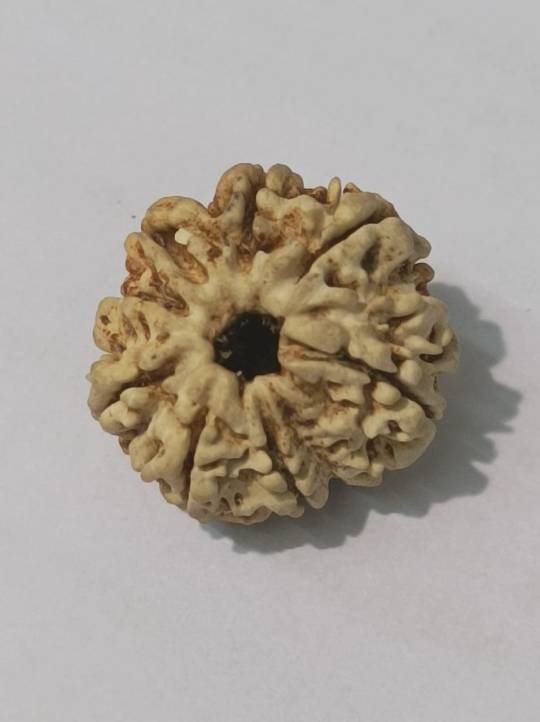
Who can wear 9 Mukhi Rudraksh – Those who have fear of death or any other kind of fear, they should certainly wear Navamukhi Rudraksha. If worn along with Dashmukhi and Ekadashmukhi Rudraksh it becomes a tremendous means of protection. 9 Mukhi (9 faced) Rudraksh is recommended for both males and females alike. It can be worn especially by career-oriented females to attain success and growth. They can wear it alone or with other mukhi beads. A devotee of Maa Durga who wears 9 Mukhi Rudraksh is blessed with good luck, happiness and prosperity in life.
Benefits of 9 Mukhi Rudraksh – This bead symbolizes Devi Durga who is considered to be all powerful. Wearing 9 Mukhi Rudraksh helps in eliminating all sorts of fears and evils. Worshipers of the Supreme Divine Power must wear it. It provides the wearer with the armor of Maa Durga, which protects him from all kinds of untoward incidents. This is one of the most useful Rudraksha for women, because Maa Durga’s armor is impregnable. Navmukhi Rudraksha increases self-confidence and makes one fearless.
The mantras for wearing Navamukhi Rudraksha are:
Om Hree Namah (Shivpuran)
Om Hum Namah (Mantramaharnav)
How to activate 9 Mukhi Rudraksh – You should wear only after properly cleaning the original holy Rudraksh with Panchamrit, raw cow milk and Gangajal. There after the mantra should be chanted 108 times to energize or activate the holy Rudraksh. It can be worn as a pendant or around the neck as mala in silver or gold capping.
Contact Detail - 222, Agarwal tower, I.P.Extension, Patparganj, Delhi, 110092 Mob No. 7042891757
#Which Rashi can wear 9 Mukhi Rudraksha?#Who is the ruling god of 9 Mukhi Rudraksha?#9 मुखी रुद्राक्ष कौन सी राशि पहन सकती है?#original 9 mukhi rudraksha price#9 mukhi rudraksha price in india#9 mukhi rudraksha benefits#9 mukhi rudraksha side effects#9 mukhi rudraksha original#9 mukhi rudraksha mala#9 mukhi rudraksha bracelet#9 mukhi rudraksha for which planet#9 Mukhi Rudraksha: Benefits#Powers And Significance#9 Mukhi Rudraksha#Benefits of 9 Mukhi Rudraksha Nepal#Natural 9 Mukhi/Face Rudraksha (Nepal Origin)#9 Mukhi Rudraksha Original
0 notes
Text
Worship Maa Skandamata on the 5th day of Navaratri

🌹 Worship Maa Skandamata on the 5th day of Navaratri 🌹
The 5th day of Navratri is dedicated to Goddess Skandamata, the 5th manifestation of Goddess Durga and the mother of Lord Kartikeya, who was chosen by the devatas as their commander in chief in the war against the demons. The image of Devi Skandamata portrays Her holding Lord Skanda in his infant form and a lotus in her right hand. She has four arms, three eyes and a bright complexion. She is also called as Padamasani since She is often depicted seated on a lotus flower in a her idol. She is also worshiped in the form of Parvati, Maheshwari or Mata Gauri. The left arm of the goddess is in a pose to grant boons with grace to her devotees.
The legend says that Tarkasur, a great demon, once pleased Lord Brahma with his great devotion and extremely tough penance. He asked Lord Brahma to shower His blessings and make him immortal. Lord Brahma denied him this blessing, saying none can escape death. Tarkasur acted smart and asked for the death by the son of Lord Shiva, since he thought Lord Shiva would never get married. Tarkasur started tormenting the people on the earth. Fearing his strength would cause destructions, the devatas requested Lord Shiva to get married. He agreed and married Goddess Parvati. Their child, Lord Kartikeya/ Skand Kumar, demolished Tarkasur. Devi Skandmata is a symbol of the mother-son relationship.
By worshipping Her, you get immense love and affection from her and gets all his desires fulfilled. You may attain supreme joy even in this very mortal world. Her worship automatically includes the worship of Lord Kartikeya (in his child form).
🍀. Spiritual Significance :
As Skanda Mata , the Goddess is Mother to Kartikeya . Kartikeya is known as Deva Senapati , the commander in chief of Gods . He takes down all the negativity / Asuras which are offsprings of material desires in mind . As her son he clears the path for her devotee by defeating all the compulsions in mind . Once peace and silence takes over mind , the devotee becomes meditative and he experiences the Divine consciousness which is Devi , or Skanda Mata . Skanda or Kartikeya has six heads , which represents his victory over six kinds disorders in human mind . He holds the shoola which is given by his Mother to fight against evil. Worship of Skandmata , bestows the grace of both Kartikeya swami and Jagadamba to a devotee. We invoke the blessings of fifth manifestation of Devi Durga on Sri Panchami of Sharad Navaratri .
🌻 Mantra and other facts
Recite the below-mentioned Mantras to get the blessing from the almighty Skanda Mata.
ॐ देवी स्कन्दमातायै नमः
Om Devi Skandamatayai Namah॥
या देवी सर्वभूतेषु माँ स्कन्दमाता रूपेण संस्थिता।
नमस्तस्यै नमस्तस्यै नमस्तस्यै नमो नमः
Ya Devi Sarvabhuteshu Ma Skandamata Rupena Samsthita Namastasyai Namastasyai Namastasyai Namo Namah ||
🌹 🌹 🌹 🌹 🌹
#జ్ఞానవాహిని#Spiritual#Bhakthi#Insight#సందేశాలు#Jnanavahini#message of the day#Devi Navaratri#prasad bharadwaj
1 note
·
View note
Text
Maa #Skandamata is the title of Devi Durga's fifth avatar. She is venerated on the fifth #Navratri because it is among the fifth Nava Durga. May Goddess Skandamata bless you with the best of everything you deserve. We Wish you a joyous and vibrant Navratri

0 notes
Text
Give me the significance of Navratri
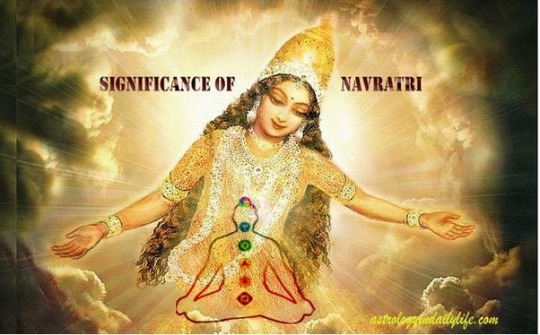
Navaratri is a Hindu festival that holds great significance in India and among Hindu communities worldwide. The word "Navratri" is derived from two Sanskrit words: "nava," meaning nine, and "ratri," meaning night. It is a festival that spans nine nights and ten days and is celebrated in honor of the goddess Durga, who represents the divine feminine energy, often referred to as Shakti. The significance of Navratri includes several key aspects:
Worship of the Divine Feminine: Navratri is a celebration of the goddess Durga and the divine feminine energy in Hinduism. It honors the strength, power, and protective qualities of the goddess, as well as her ability to vanquish evil and restore balance to the world.
Victory of Good over Evil: Navratri marks the victory of goddess Durga over the demon Mahishasura, symbolizing the triumph of good over evil. It reminds people of the importance of righteousness and the defeat of negative forces.
Worship of Different Forms of the Goddess: During Navratri, different forms or incarnations of the goddess are worshiped over nine nights. These forms include Shailaputri, Brahmacharini, Chandraghanta, Kushmanda, Skandamata, Katyayani, Kalaratri, Mahagauri, and Siddhidatri. Each form represents different aspects of the goddess's power and qualities.
Fasting and Penance: Many people observe fasting and engage in acts of penance during Navratri as a way of purifying the body and mind, seeking blessings, and demonstrating devotion to the goddess.
Dance and Music: In some parts of India, especially in the western state of Gujarat, Navratri is marked by colorful and energetic dance forms like Garba and Dandiya Raas. These dances are performed to celebrate the goddess and create a sense of community and joy.
Community and Togetherness: Navratri is a time when families and communities come together to celebrate. It's a time for social gatherings, sharing meals, and participating in various cultural and religious activities.
Rejuvenation of Life: Navratri also marks the change of seasons, transitioning from the monsoon to the autumn season in India. It symbolizes the rejuvenation of life and the coming of new beginnings.
Cultural Significance: The festival has cultural significance beyond its religious aspects. It is a time for traditional music, dance, and art forms. It also provides a platform for local artisans and craftsmen to showcase their work.
Overall, Navratri is a celebration of the divine feminine, the victory of good over evil, and the renewal of life. It's a time for reflection, devotion, and joy, and it holds deep cultural and spiritual importance in Hinduism. Different regions in India may have variations in the way Navratri is celebrated, but the core significance remains consistent.
Navratri festival,
Durga Puja,
Navratri celebration,
Significance of Navratri,
Nine nights of Navratri,
Hindu festival Navratri,
Goddess Durga worship,
Navratri traditions,
Garba dance,
Navratri fasting,
Navratri colors,
Navratri mythology,
Navratri rituals,
Devi worship in Navratri,
Navratri puja,
Maa Durga's blessings,
Navratri significance in Hinduism,
Navratri vrat,
Maha Navratri,
Dandiya Raas,
Navratri customs,
Navratri goddesses,
Navratri spiritual importance,
Chaitra Navratri,
Navratri festival in India,
1 note
·
View note
Text
The Divine Significance of the 5th Day of Navratri: Celebrating Maa Skandamata
Navratri, the nine-night festival dedicated to the worship of the divine feminine energy, holds immense importance in Hindu culture. Each day of Navratri is dedicated to a different form of Goddess Durga, and on the 5th day, we celebrate Maa Skandamata. Known as the mother of Skanda or Lord Kartikeya, Maa Skandamata signifies motherly love, protection, and nurturing energy. Let us explore the divine significance of the 5th day of Navratri and how we can celebrate it to invoke her blessings.
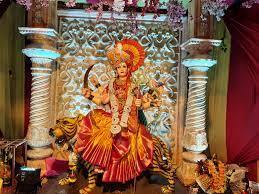
The Graceful Form of Maa Skandamata
Maa Skandamata adorns a radiant appearance, sitting on a lotus flower, with Lord Skanda on her lap. She possesses four arms, holding a lotus in two of them while her other two hands are in Abhaya (blessing) and Varada (giving) mudras. This manifestation symbolizes her motherly love and blessings, as she protects her devotees and grants boons, just as a caring mother does for her children.
Her Divine Significance
Maa Skandamata is worshipped on the 5th day of Navratri for numerous reasons. She represents the bond between a mother and child, highlighting the importance of nurturing and protection. Her presence reminds us of the strength and resilience required in both physical and spiritual motherhood. She blesses her devotees with love, care, and guidance, empowering them to face challenges with courage and determination.
Celebrating Maa Skandamata's Special Day
To celebrate the 5th day of Navratri and honor Maa Skandamata, devotees engage in various rituals and practices. The following are a few ways to make the most of this auspicious day:
Dressing Traditionally: Adorn yourself in traditional attire, preferably in shades of yellow, which is considered auspicious for this day of Navratri. It symbolizes brightness, positivity, and cheerfulness, reflecting the divine energy of Maa Skandamata.
Setting Up the Altar: Create a dedicated altar or puja space with flowers, incense, and a picture or idol of Maa Skandamata. Offer fresh fruits, sweets, and other traditional items as a sign of devotion.
Chanting Mantras and Singing Bhajans: Recite Maa Skandamata’s mantra "Om Devi Skandamatayai Namah" and melodious bhajans dedicated to her. This practice helps connect with her divine presence and invokes her blessings.
Observing Fasting: As a mark of devotion, some devotees observe a fast on this day. Fasting purifies the body, mind, and soul, enhancing the spiritual connection with Maa Skandamata. It is customary to consume simple satvik meals consisting of fruits, vegetables, and nuts.
Embracing Motherly Love: Take time to appreciate and honor the love and sacrifice of your own mother or mother figures. Show gratitude for their unconditional care and support, just as Maa Skandamata embraces her devotees with love and protection.
Conclusion
The 5th day of Navratri is a time to celebrate the divine essence of Maa Skandamata, the epitome of motherly love, protection, and guidance. Through her blessings, devotees are inspired to embrace their own strength and nurture their surroundings with utmost care. By celebrating this day with devotion and gratitude, we deepen our connection with Maa Skandamata, seeking her protection and blessings on our spiritual journey. May the 5th day of Navratri fill our lives with love, positivity, and the energy of divine motherhood.
0 notes
Text
Are you celebrating this Sharada Navaratri?
Are you celebrating this Sharada Navaratri?
Sharada Navaratri is one of the biggest Hindu festivals of the year. The festival is celebrated over nine nights and ten days from September 26th to October 4th, 2022 with festivities varying across India. The festival is celebrated in the Hindu month of Ashvin and is considered as being an auspicious time of the year. Although Navaratri (sometimes spelled as Navratri) comes every month, there…
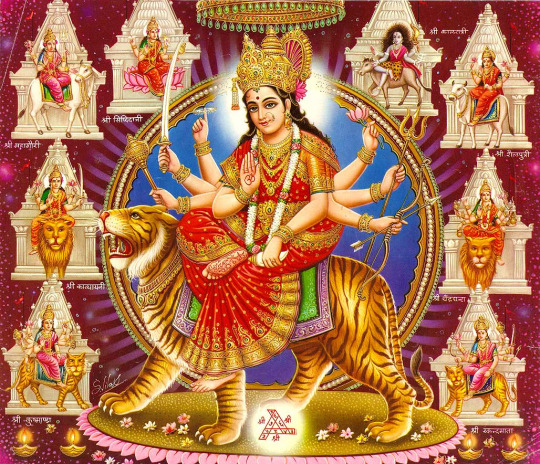
View On WordPress
#Ashada Navratri#Chaitra Navratri#Devi Maa Brahmacharini#Devi Maa Chandraghanta#Devi Maa Kalratri#Devi Maa Katyayani#Devi Maa Kushmanda#Devi Maa MahaGauri#Devi Maa ShailPutri#Devi Maa Siddhidatri#Devi Maa Skandamata#Durga#fast#fasting#Festival#Goddess Durga#health#immune system#India#Lentils#Magha Navratri#Navaratri#Navaratri Vrat#Raffaello Palandri#Raffaello Palandri Yoga Teacher#Ratri#Sharada Navratri#Vasant Panchami#Vrat#Yoga
1 note
·
View note
Text
9 FORMS OF GODDESS DURGA
Reading Time- 6 mins
Step into the vibrant land of India, where ancient traditions blend seamlessly with modern times. One such exhilarating extravaganza that captivates the nation every year is the dazzling festival of Navratri. Enveloped in mythological tales and steeped in historical significance, Navratri is an electrifying celebration that showcases India's rich cultural tapestry. Join us on a journey through time as we unravel the captivating origins and spellbinding stories behind this remarkable festival!
Navratri, (“Nav” meaning Nine, & “Ratri” meaning Night), is one of the most revered Hindu festivals observed in honor of the Goddess of strength-“Maa Durga”. According to ancient legends, an invincible demon king named Mahishasura threatened the existence of gods and mortals alike. In their desperate plea for help, the gods united their powers, and Devi Durga emerged, a fierce and formidable goddess. Goddess Durga is the feminine epitome of destruction, protection, motherhood, and wars. She is often depicted with many arms, each carrying a weapon and defeating the demons while riding a tiger.
The festival of Navratri is celebrated twice a year: “Chaitra Navratri” is celebrated in the month of March-April and “Sharad Navratri” is celebrated in the month of September-October. Both festivals are associated with Maa Durga and are believed that the goddess remains on the earth for nine days to bless her devotees & rid the earth of all negative energies. Chaitra Navratri, which falls during the Shukla Paksha of Chaitra every year, signifies the beginning of the Hindu New Year as per the Hindu calendar. During the nine-day festival, the goddess Durga's nine forms are worshipped and celebrated with great enthusiasm all over India. The devotees observe fast for nine days to attain the blessing of the goddess. These nine days are solely dedicated to the 9 incarnations of Maa Durga which are:
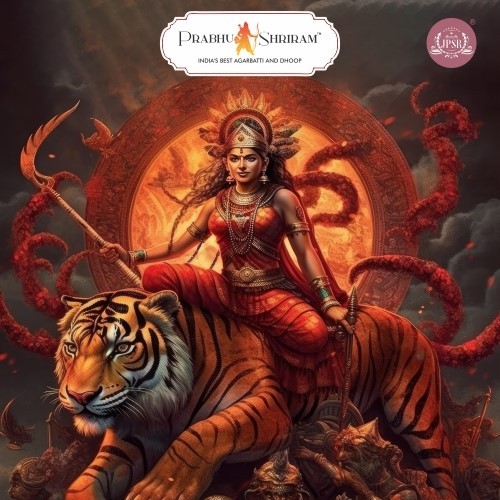
Day 1- Maa Shailputri (Daughter of Mountain)
The Goddess “Shailputri” is worshipped on the first day of Navratri. She was the daughter of the King of Mountains, Himavan. She is depicted with light ornamentation on her limbs and is robed in red and pink colored cloth. She has two hands both holding a trident and lotus and is shown seated upon a white bull.
Day-2 Maa Brahmacharini (Mother of Devotion and Penance)
The Goddess “Brahmacharini” is worshipped on the second day of Navratri. “Brahma” means “Tapa” and “Charini” means “an ardent female follower”. She is seen dressed as a female ascetic and is adorned with dried Rudraksha Beads and Flowers ornamentation. She has two hands both carrying a rosary and water utensils.
Day-3 Maa Chandraghanta (Destroyer of Demons)
The Goddess “Chandraghanta” is worshipped on the third day of Navratri. Her forehead is bedecked with a Crescent Moon resembling the shape of a temple bell. She is seen seated upon a fierce tiger with her nine armed by a trident, mace, bow, arrow, lotus, sword, bell, and a waterpot, while one other hand blesses her devotees.
Day-4 Maa Kushmanda (Goddess of the Cosmic Egg)
The Goddess “Kushmanda” is worshipped on the fourth day of Navratri. “Ku” means little, “Ushma” means “warmth or energy”, and “Anda” means “Egg”. This form of Shakti is a happy manifestation of the Goddess. She is mounted on the back of a Lion with eight to ten hands, holding a trident, discus, sword, hook, mace, bow, arrow, and two jars of honey (Elixir) and blood.
Day-5 Maa Skandamata (Goddess of Motherhood and Children)
The Goddess “Skandamata” is worshipped on the fifth day of Navratri. “Skanda” is another name for Kartikeya and Skandamata means “The Mother of Kartikeya”. She is seen seated upon the back of a Lion with four hands. Her two hands are holding lotuses, the third holding her six-headed infant Kartikeya and the fourth hand blessing her devotees.
Day-6 Maa Katyayni (Goddess of Power)
The Goddess “Katyayni” is worshipped on the sixth day of Navratri. She represents Durga in the warrior stage. She is seen sitting on a fearsome lion and is adorned with heavy ornamentation on her limbs and is dressed in green and pink vestments. She has four hands each carrying a sword, shield, lotus, and trident.
Day-7 Maa Kaalratri/Kaali (Goddess of Auspiciousness and Courage)
The Goddess “Kaalratri/Kaali” is worshipped on the seventh day of Navratri. “Kaal” means “Time or Death” and “Ratri” refers to darkness/ignorance. Therefore, Kaalratri means the one who puts an end to darkness & ignorance. Representing Durga in the form of Destruction, she is seen mounted upon a donkey as her vehicle. She has three bloodshot eyes and unkempt hair wearing a garland of skulls around her neck. She has four hands holding a trident, a scimitar, a vajra, and a cup.
Day-8 Maa Mahagauri (Goddess of Beauty and Women)
The Goddess “Mahagauri” is worshipped on the eighth day of Navratri. She represents Durga in her Recovery and is seen sitting upon a white ox. She has four hands, three of which carry a trident, a mini drum, and a pink lotus, while her fourth hand blesses her devotees with protection.
Day-9 Maa Siddhidatri (Goddess of Supernatural Powers or Siddhis)
The Goddess “Siddhidatri” is worshipped on the final day of Navratri. Representing Durga in her highest and supreme form of Mahashakti, she is seen sitting on a fully bloomed lotus. She has four hands carrying a discus, conch shell, pink lotus, and a mace.
It is said that Navratri is the time when nature begins to bloom & supports the creation of positive energies during this time, which makes these nine nights more sacred. Navratri Puja is conducted with supreme dedication by devotees to please Goddess Durga. Prabhu Shriram- India’s Best Agarbatti and Dhoop brings to you premium fragrances that make you feel the essence & presence of the supreme Goddess in the comfort of your home. The “Navratri Puja Kit” includes all the Puja essentials to conduct the puja & get the divine blessings of Maa Durga. The ”Upasana” Agarbatti from the Life & God Collection has a unique fragrance that instills your prayers with Maa Durga’s Shakti. The holy fragrance of “Mata Vaishno Devi Agarbatti” from the Incredible Temple Collection lets you offer your prayers to Maa Durga and fill your house with the soulful fragrance of the Mata Vaishno Devi temple.
In the present day, Navratri continues to evolve, blending tradition with contemporary elements. From celebrity performances to innovative dance forms, the festival embraces new dimensions while holding onto its timeless essence. Social media platforms and digital spaces amplify the celebrations, connecting people from all corners of the world and spreading the infectious enthusiasm of Navratri to new generations.
#durga#matavaishnodevi#life&godcollection#upasana#maasiddhidatri#maamahagauri#maakaalratri#maakatyayni#maaskandamata#maakushmanda
0 notes
Text
#संपन्नमाया
सर्वोत्तम गुणवत्ता और शुद्ध #अगरबत्ती, कुमकुम, हल्दी, चंदन पेस्ट/चंदन, विभूति, और अन्य #पूजा सामग्रियों के लिए www.sampannamaya.com पर जाएं।
#sampannamaya #sampannamayapvt #india #sampannamayaprivetlimited #agarbatti #dhoop #dhoopbatti #incensesticks #fragrance #hindugod #iskcon #iskcontemple #shiva #dhoopsticks #eksachhiprarthana #msme #makeinindia #premiumdhoopbatti #navratri #durgapuja #jaimatadi #durga #devi #maadurga #maa #durgamaa #happynavratri #skandamata #navratri

#agarbatti#incense#incense sticks#prayers and rituals#dhoop#home and lifestyle#bhagwan shiv#maa durga#durga puja#msme ministry#make in india#sampannamaya#sampannamaya (opc) private limited#dhoop sticks
6 notes
·
View notes